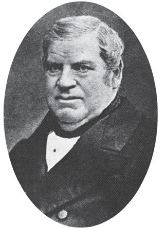Name Jonas Jonsson Role Designer | Died November 7, 1885 | |
 | ||
Jonas Jonsson (1806 – 7 November 1885) was a Swedish master builder from Eksjö, Sweden, who built many churches, important town buildings in Stockholm, and lighthouses along the Swedish coast.
Jonsson was born in a smallholding outside Eksjö in 1806. Little is known of his early years or education. Lars Strömbäck assumes in his short biography that the boy was apprenticed to a local builder. Records from 1826 mention Jonsson as "verkmästare", foreman, at the building of the empire style church in Lofta, designed by the prominent architect Per Axel Nyström. Johnson was to collaborate for many years with Nyström, and had by 1836 progressed to being in full charge of the building of Nyström's church in Utna.
Jonsson was prodigiously productive throughout his career. This took place at a time when the Empire style was popular throughout Europe; particular so in Sweden where it had been introduced by King Karl Johan of Sweden and Norway, the former Marshal of France General Bernadotte, where it was named after the king as the Karl Johan style. The style remained popular in Scandinavia throughout the nineteenth century. This fashion was sustained by France paying some of its debts to Sweden in ormolu bronzes rather than money.
The buildings Jonas Jonsson supervised were often designed by prominent architects such as Nyström, Jöran Folke Oppman and Folke Birger Oppman, and were financed by parishes, the Swedish state, or rural nobility and gentry. His influence on building practices in Tjust was such that the characteristic Tjust empire style was sometimes referred to as the "Jonsson empire style". He also gradually acquired some architectural skills, and is himself the architect of several buildings such as Linköping Savings Bank and Vimmerby City Hotel.
The rapid growth of shipping in the mid-19th century led to a need for more lighthouses along the Swedish coasts, and Jonsson was responsible for many new or refurbished lighthouses during the 1840s: Vinga, Hållö, Kullen, Morups Tånge, Långe Erik, Fårö, Landsort and more. He was so successful as a lighthouse-builder that he was eventually offered such jobs without the standard tender procedure for government-financed buildings. However, there are also records of complaints from both workers and government inspectors, giving a picture of an unyielding man.
Jonsson married Fanny Sundström in 1842 and they had four children. Strömbäck describes Jonsson as an example of social mobility: from humble rural beginnings, he became a wealthy citizen of the thriving city of Linköping, owner of several houses and member of the city council.
